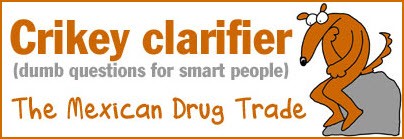We know them as faraway characters on trashy TV shows: cavorting by luxurious pools, getting shot at by their enemies and, if it’s a bad day, floating face down in murky rivers. But according to a Sydney Morning Herald report today, Mexican drug lords have infiltrated Australia.
That’s right, the cocaine your local junkie is snorting hasn’t come from just any old drug baron — this stuff is from the big boys at the Sinaloa cartel, one of the world’s largest and most powerful drug rings.
According to the Herald’s article, police now believe that Sinaloa has “smuggled about half a tonne of cocaine a month into Australia over the previous 30 months”. Crikey, as always, asks the tough questions…
How do members of such large illegal organisations avoid the authorities?
Cartel leaders are anything but anonymous — in fact, they seem more like celebrities than outcasts. The inclusion of Sinaloa head honcho Joaquín Guzmán Loera at #937 on the Forbes list of billionaires (with an estimated worth of $1 billion) is the perfect example of this. So how, with such public exposure, do these guys steer clear of the authorities?
Jack Riely, a US special agent, was quoted in Time as saying that Guzmán “remains fairly safe in Mexico because of his influence and his ability to corrupt”. With the huge amount of money at its disposal, Sinaloa has the power to buy off local police easily. However, US federal operations are regularly undertaken to find kingpins such as Guzmán.
So far, Guzmán has managed to avoid capture by moving between a series of safe houses and strongholds throughout Mexico, accompanied by up to 10 bodyguards. In a large and widely under-developed country, this has proven an extremely effective method of avoiding capture.
So is anyone getting caught?
Yep, they’re not all as evasive as Guzmán. So far this year, several key figures in the trade have been either captured or killed, including Sinaloa third-in-charge Ignacio Coronel, Edgar Valdez Villarreal of the Beltrán-Leyva Cartel and, in the past few days, Sergio Villarreal Barragan (aka ‘El Grande‘), also a senior figure in Beltrán Levya. While these captures are undoubtedly a moral victory for authorities, the people are replaceable, and the cartels remain strong.
What impact are these cartels having on Mexico?
An Associated Press article written in August reported that, since Mexican President Felipe Calderon declared a war on drugs in 2006, “more than 28,000 people have been killed in drug violence”.
Unfortunately, when given a choice between supporting their government and continuing to hide the drug lords, many Mexican people feel safer siding with the cartels, despite their violent ways. This is, in part, because of the cartels’ willingness to pay them in exchange for their silence and the use of their houses as a hide-out in emergencies.
In a 2005 profile of Guzmán, the LA Times reported “although Mexican officials call him one of the most prolific, innovative and ruthless traffickers they have ever faced, his disappearing acts have made him a folk hero”. Guzmán’s Ned Kelly-like status is an indication that many Mexican people see drug lords not as criminals, but as revolutionaries against what can be an oppressive government.









It is difficult to see how this article constitutes a “clarifier” when it assiduously avoids one of the most significant facts about the Mexican drug cartels and that is their involvment, and the Sinaloa cartel’s involvement in particular, with the CIA.
The close involvement of the CIA in drug trafficking is well documented: see for example the books by Alfred McCoy and Peter Dale Scott on the topic. Gary Webb exposed the link in a series of articles for the San Jose Mercury in August 1996 and although widely condemnded by such establishment giants as the NY Times and the Washington Post was subsequently vindicated by the CIA’s Inspector General Report in 1998. Webb was later “suicided” for his temerity.
Daniel Hopsicker has also written widely on the topic. He recently exposed the truth behind the crash of a Gulfstream aircraft on the Yucatan Peninsula in September 2007. The aircraft was registered to a CIA front company and had also been used for CIA rendition flights to Guantanamo.
Mike Whitney has an article in the Pacific Free Press dated 26 April 2010 in which he discusses the real answers to the question posed by your reporter as to why the leaders of these cartels lead such a charmed and prosecution free life: they enjoy protection from the very top. In Mexico’s case that is from US supported President Calderon.
Despite Webb’s revelations and those of others the media still persist in running articles such as the above and avoiding the very real nature of this dangerous and highly profitable trade.
I would dearly like to know what these drug lords are doing with the money they make and particularly how they spend that money. I mean what’s the point of having billions if you don’t spend it ? Any ideas?